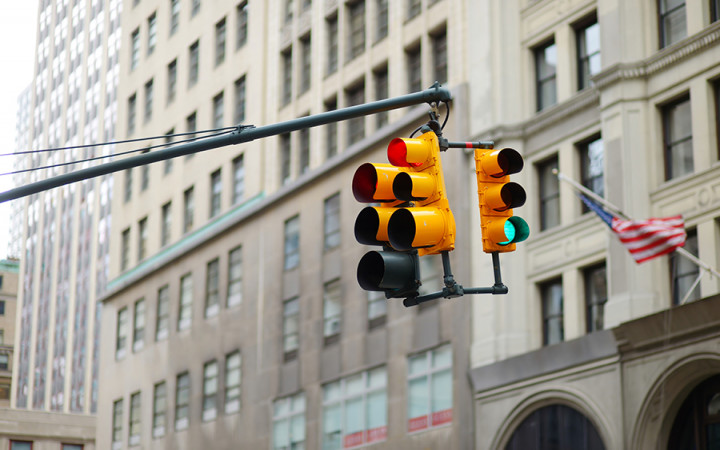Today’s Wonder of the Day was inspired by Auora. Auora Wonders, “how does a traffic light work?” Thanks for WONDERing with us, Auora!
We were sitting at the Wonderopolis bus stop the other day when we overheard two dogs discussing the traffic at the nearby intersection:
Dog 1: So what you're telling me, Charlie, is that these humans drive these cars around and just stop for no reason simply because there's a red light hanging up in the air?
Dog 2: I know it sounds crazy, Rex, but I've watched the cars here for quite a while and that indeed appears to be what happens. Sit here and watch with me a while.
Dog 1: Would you look at that, Charlie? You're right. That car was driving along and, even though there aren't any other cars around, it just stopped when that light up there turned from green to yellow and then red.
Dog 2: It's a mystery, Rex. Why would they do that? It's almost like they don't have anywhere important to be. It's like they've got all the time in the world and are never in a hurry.
Dog 1: People are so weird. I'll never understand them. Oh well, I need to get back home to chase cats and bark at leaves.
Dog 2: Look! That car is coming this way. Let's chase it!
Rex and Charlie took off in a flurry of fur and barking. We're not sure if they ever caught the car or, if they did, what they would've done with it. Nevertheless, their brief conversation did make us WONDER about the traffic lights that hang above intersections. Exactly how do those work?
While traffic signals may be a mystery to dogs, human drivers are happy that they're there to regulate the flow of traffic on busy streets. Without traffic lights and stop signs, navigating your way around a big city could be quite dangerous.
As you probably already know, most traffic lights feature three colored lights. The green light signals that it's safe to proceed through the intersection. A yellow light (also known as a caution light) alerts drivers to the fact the light is about to change to red.
When drivers encounter a yellow light, they know it's necessary to slow down and come to a stop at the intersection. The red light, of course, indicates that drivers must stop and wait for a green light before traveling through the intersection.
Although most traffic lights have a similar appearance, they can often function in very different ways. The most common traffic lights work on simple timers. Depending upon traffic levels at a particular intersection, the traffic light will cycle through green, yellow, and red at regular intervals to ensure a consistent flow of traffic in all directions through the intersection. Timer-based systems are excellent for busy areas that have a consistent, heavy volume of traffic.
In areas where traffic can be sporadic and unpredictable, timer-based systems don't work as well. For example, in a rural area, a timer-based system might have drivers stopped unnecessarily when no traffic is present. In these situations, sensor-based traffic signals maximize traffic efficiency by only functioning when traffic is present.
Rather than timers, "smart" or "intelligent" sensor-based traffic signals rely upon a system of sensors to detect when vehicles are present. The types of sensors used can vary by location and technology. Some systems use lasers, rubber hoses filled with air, or video cameras to detect the presence of cars.
Another popular type of sensor is known as an inductive loop system. These systems rely upon a coil of wire embedded in the road's surface. The wire detects changes in magnetic fields when vehicles (large metal objects!) are stopped above them.
So how do sensor-based systems maximize traffic efficiency? In a rural area, for example, the main direction of travel can remain on green to allow the majority of vehicles to pass through quickly. When a vehicle on a side road arrives at the intersection, a sensor will detect it and cycle the lights to allow traffic on the side road to pass through. In this way, traffic can flow uninterrupted on the main road unless and until traffic on a side road appears.
Some traffic signals in large cities are even advanced enough to allow certain types of vehicles to control them when necessary to allow quick passage through intersections for certain types of vehicles. These systems, known as traffic preemption systems, allow emergency vehicles, such as ambulances, fire trucks, and police cars, to change traffic signals as they approach, so that they can get to where they need to go much faster.





